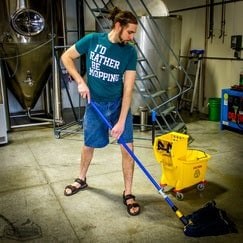But, you see, loving to mop is sort of an artifact of my job. Most people think professional brewers are just drinking and kicking-back all the time. Wrong. We are glorified janitors. (Ok, let’s be honest, I’m usually drinking and chilling when I mop.)
Being a brewer, professional or at home, is 95% cleaning and sanitizing. Godliness is next to cleanliness after all. [1] Without clean and sanitized equipment, you’re just asking for infections. So, without getting into sterilization of must (boiling or sulfating your honey and water mixture), let’s talk about getting your equipment ready.
Step 1: CLEAN. Before you can sanitize, everything needs to be clean. Do not use soap unless, for reasons that we cannot imagine, there is somehow oil on your brewing equipment. No, let’s say this more forcefully: There should never be oil on your brewing equipment. So get yourself a good brewing cleanser like B-Brite or PBW (our house favorite). Soak and scrub everything. Make sure to use a soft bristle or a rag on anything that can scratch (like plastic).
Step 2: SANITIZE. There’s a huge divergence of opinion here, some people love using very inexpensive watered-down bleach, others advocate for environmentally friendly alternatives like hop-water. The problem is that this is not a matter of opinion, but rather of science. Bleach is, indeed, inexpensive, but it can easily lead to batch ruining chlorophenols. Hop-water is not only outrageously expensive, but also supremely ineffective. Just go to your local homebrew shop and buy a no-rinse sanitizer. No-rinse is the key here, you do not want to rinse off whatever you used to sanitize since that will, y’know, undo the sanitization process.
Very super optional, probably even disrecommended Step 3: STERILIZE. There are very few situations in which the homebrewer – or even the pro brewer for that matter – will be called upon to sterilize equipment. There is essentially only one way to sterilize and that is with a combination of pressure and heat. In other words, read “highly pressurized steam.” Unless you are trying to propagate your own yeast strain, better leave off with sanitizing. Shards of hot, broken glass embedded in your hand do not a fun brew-day make.
And that’s it: Clean then sanitize then brew. It’s really pretty simple, but extremely important. Read the directions, have a good time, and someday you could learn to love cleaning like I do.
[1] Ricky the Meadmaker, in response to seeing “God Bless this Mess” hanging in a home office was once heard to say, “Madam, God does not bless this mess. Cleanliness is next to godliness, and in so much, what you have here is an affront to your Lord. Whomever you pray to surely does not condone this atrocity. Surely, rather than asking for God’s blessings, you ought to beg for God’s forgiveness.” He is not welcome in several homes in suburban Des Moines any longer.





